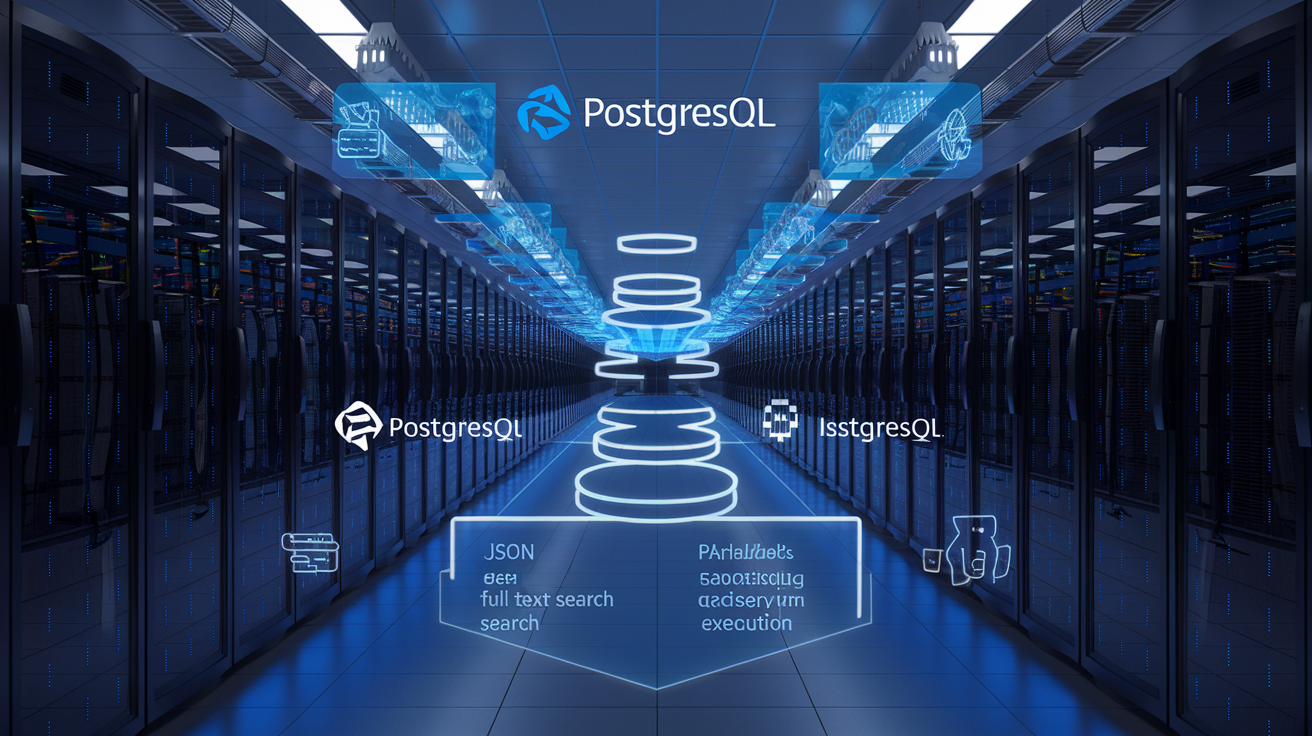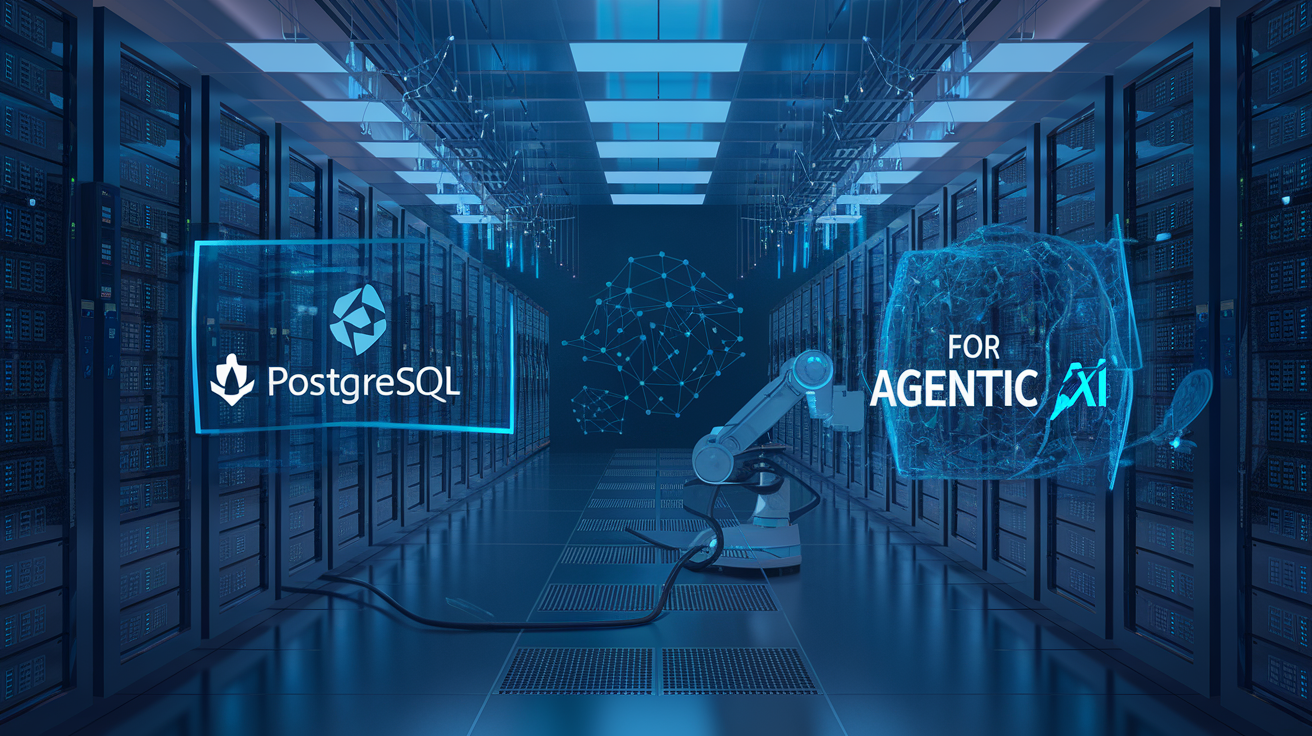🤖 Imagine a world where artificial intelligence not only processes data but actively makes decisions and takes actions. This is the realm of agentic AI, and it’s revolutionizing how we interact with technology. But here’s the burning question: How do we power these intelligent agents with the robust, reliable data they need to function? Enter PostgreSQL, the unsung hero of the AI world.
PostgreSQL, or Postgres for short, isn’t just another database system. It’s a powerhouse that’s quietly transforming the landscape of AI development. From data preprocessing to model training, and from ensuring security to scaling for massive deployments, Postgres is the backbone that many cutting-edge AI systems rely on. But why is this open-source database gaining such traction in the AI community?
In this deep dive, we’ll explore how PostgreSQL is being leveraged to create more intelligent, more responsive, and more reliable AI agents. We’ll uncover the unique features that make Postgres a go-to choice for AI developers, and we’ll look at real-world examples of how it’s being used to push the boundaries of what’s possible in artificial intelligence. Whether you’re a seasoned data scientist or just AI-curious, buckle up – we’re about to embark on a journey through the exciting intersection of databases and artificial intelligence. 🚀
Understanding PostgreSQL’s Role in AI Development

Key features of PostgreSQL for AI applications
PostgreSQL offers several key features that make it an excellent choice for AI applications:
-
Advanced Data Types:
- JSON and JSONB for flexible data storage
- Array and Hstore for complex data structures
- Full-text search capabilities
-
Extensibility:
- Custom functions and operators
- Pluggable storage engines
- Foreign data wrappers for connecting to external data sources
-
Analytical Functions:
- Window functions for complex calculations
- Common Table Expressions (CTEs) for recursive queries
- Materialized views for caching query results
| Feature | Benefit for AI |
|---|---|
| JSON support | Flexible storage of unstructured data |
| Array data type | Efficient storage of multi-dimensional data |
| Full-text search | Natural language processing capabilities |
| Custom functions | Implementation of AI algorithms directly in the database |
Advantages over other databases for AI workloads
PostgreSQL offers several advantages over other databases when it comes to AI workloads:
- Open-source nature: Allows for customization and community-driven improvements
- ACID compliance: Ensures data integrity for critical AI applications
- Strong consistency model: Provides reliable data for AI model training
- Rich ecosystem of extensions: Enhances AI capabilities with specialized tools
PostgreSQL’s scalability and performance benefits
PostgreSQL’s scalability and performance features are particularly beneficial for AI applications:
- Parallel query execution: Improves performance for complex AI data processing tasks
- Partitioning: Enables efficient management of large datasets common in AI
- Index-only scans: Accelerates data retrieval for AI model training and inference
- Just-in-Time (JIT) compilation: Optimizes query execution for repetitive AI workloads
| Feature | Performance Benefit |
|---|---|
| Parallel query | Faster processing of large datasets |
| Partitioning | Improved query performance on big data |
| Index-only scans | Reduced I/O for frequent data lookups |
| JIT compilation | Optimized execution of complex AI queries |
These scalability and performance benefits make PostgreSQL an excellent choice for handling the large-scale data processing requirements of modern AI systems. As we move forward, we’ll explore how to integrate PostgreSQL with popular AI frameworks to leverage these advantages in practice.
Integrating PostgreSQL with AI Frameworks

Connecting PostgreSQL to popular AI libraries
PostgreSQL’s robust architecture and extensive feature set make it an ideal database for AI applications. Connecting PostgreSQL to popular AI libraries is straightforward and efficient, enabling seamless data flow between your database and machine learning models.
Here’s a comparison of PostgreSQL integration with popular AI libraries:
| AI Library | Integration Method | Key Features |
|---|---|---|
| TensorFlow | psycopg2 + tf.data API | Efficient data loading, GPU acceleration |
| PyTorch | SQLAlchemy + torch.utils.data | Custom datasets, parallel processing |
| Scikit-learn | pandas + sklearn.preprocessing | Easy data manipulation, feature scaling |
| Apache Spark | JDBC driver + Spark SQL | Distributed computing, large-scale data processing |
To connect PostgreSQL with these libraries, follow these steps:
- Install the appropriate database adapter (e.g., psycopg2 for Python)
- Establish a database connection using the adapter
- Execute SQL queries to retrieve data
- Transform the data into the required format for your AI library
Optimizing data retrieval for machine learning algorithms
Efficient data retrieval is crucial for machine learning performance. PostgreSQL offers several features to optimize this process:
- Indexing: Create appropriate indexes on frequently queried columns
- Partitioning: Split large tables into smaller, more manageable chunks
- Query optimization: Use EXPLAIN ANALYZE to identify and improve slow queries
- Materialized views: Pre-compute and store complex query results for faster access
Managing large datasets efficiently for AI training
When dealing with large datasets for AI training, PostgreSQL provides powerful tools to manage and process data effectively:
- Parallel query execution: Utilize multiple CPU cores for faster data processing
- Foreign data wrappers: Access external data sources as if they were PostgreSQL tables
- COPY command: Quickly bulk load large datasets into the database
- Vacuuming and analyzing: Maintain optimal database performance through regular maintenance
By leveraging these PostgreSQL features, you can significantly enhance the efficiency of your AI workflows, from data preparation to model training and deployment.
Leveraging PostgreSQL for Data Preprocessing

Using built-in functions for data cleaning
PostgreSQL offers a robust set of built-in functions that can significantly streamline the data cleaning process for AI applications. These functions enable efficient handling of common data issues, saving time and computational resources.
- Text manipulation functions: TRIM(), UPPER(), LOWER(), REGEXP_REPLACE()
- Numeric functions: ROUND(), ABS(), COALESCE()
- Date and time functions: TO_DATE(), AGE(), EXTRACT()
Here’s a comparison of some key data cleaning tasks and their corresponding PostgreSQL functions:
| Data Cleaning Task | PostgreSQL Function | Example |
|---|---|---|
| Remove whitespace | TRIM() | TRIM(BOTH ‘ ‘ FROM column_name) |
| Standardize case | UPPER() or LOWER() | UPPER(column_name) |
| Replace values | REPLACE() | REPLACE(column_name, ‘old’, ‘new’) |
| Handle missing values | COALESCE() | COALESCE(column_name, default_value) |
By leveraging these functions directly within the database, you can significantly reduce the preprocessing load on your AI application, leading to more efficient and scalable data pipelines.
Implementing feature engineering within the database
PostgreSQL’s advanced capabilities extend beyond basic data cleaning, allowing for sophisticated feature engineering directly within the database. This approach can dramatically reduce data transfer overhead and accelerate the AI model development process.
Key feature engineering techniques in PostgreSQL include:
- Window functions for time-series analysis
- Custom aggregations for complex calculations
- Mathematical and statistical functions for derived features
Consider this example of feature engineering using PostgreSQL:
SELECT
user_id,
AVG(purchase_amount) OVER (PARTITION BY user_id ORDER BY purchase_date
ROWS BETWEEN 30 PRECEDING AND CURRENT ROW) AS avg_30_day_spend,
COUNT(*) OVER (PARTITION BY user_id ORDER BY purchase_date
ROWS BETWEEN 30 PRECEDING AND CURRENT ROW) AS purchase_frequency_30_days
FROM user_purchases;
This query calculates rolling averages and frequencies, providing valuable insights for AI models without the need for external processing.
Automating data transformation pipelines
Now that we’ve explored data cleaning and feature engineering, let’s look at automating these processes within PostgreSQL. By creating automated data transformation pipelines, we can ensure consistent, up-to-date data for our AI models.
PostgreSQL offers several tools for pipeline automation:
- Stored procedures for complex transformations
- Triggers for real-time data updates
- Materialized views for efficient data caching
Here’s an example of a simple automated pipeline using a stored procedure:
CREATE PROCEDURE update_ai_features()
LANGUAGE plpgsql
AS $$
BEGIN
-- Clean data
UPDATE raw_data SET text_column = TRIM(LOWER(text_column));
-- Engineer features
INSERT INTO ai_features (user_id, avg_spend, purchase_frequency)
SELECT
user_id,
AVG(purchase_amount),
COUNT(*)
FROM user_purchases
GROUP BY user_id;
-- Additional transformations...
END;
$$;
This procedure can be scheduled to run periodically, ensuring that your AI models always have access to the latest, cleanest data. By leveraging PostgreSQL’s powerful features for data preprocessing, you can create more efficient, scalable, and maintainable AI systems.
Enhancing AI Model Training with PostgreSQL

Storing and versioning AI models in the database
PostgreSQL offers robust capabilities for storing and versioning AI models directly within the database. This approach provides several advantages:
- Centralized management: Keep models and data in one place
- Version control: Track model iterations and changes over time
- Easy rollback: Quickly revert to previous model versions if needed
- Improved collaboration: Team members can access and work on models seamlessly
Here’s a simple example of how to store a model in PostgreSQL:
CREATE TABLE ai_models (
id SERIAL PRIMARY KEY,
model_name VARCHAR(100),
version INT,
model_data BYTEA,
created_at TIMESTAMP DEFAULT CURRENT_TIMESTAMP
);
Utilizing PostgreSQL for distributed training
PostgreSQL’s powerful features can be leveraged for distributed AI model training:
- Data partitioning
- Parallel query execution
- Connection pooling
- Replication
| Feature | Benefit for AI Training |
|---|---|
| Data partitioning | Distribute large datasets across nodes |
| Parallel query execution | Speed up data retrieval and processing |
| Connection pooling | Manage multiple concurrent connections efficiently |
| Replication | Ensure data availability and fault tolerance |
Implementing online learning with real-time updates
PostgreSQL’s real-time capabilities make it ideal for online learning scenarios. Use triggers and notifications to update models as new data arrives:
- Create a trigger function to process new data
- Set up a LISTEN/NOTIFY mechanism for real-time updates
- Implement a client-side listener to receive notifications
- Update the model incrementally based on new data
Optimizing hyperparameter tuning processes
Efficient hyperparameter tuning is crucial for AI model performance. PostgreSQL can streamline this process:
- Store hyperparameter configurations in tables
- Use SQL queries to analyze performance metrics
- Implement grid or random search algorithms within the database
- Leverage PostgreSQL’s JSON support for flexible parameter storage
By utilizing PostgreSQL’s advanced features, AI practitioners can significantly enhance their model training workflows, from versioning and distributed training to online learning and hyperparameter optimization.
PostgreSQL’s Advanced Features for AI Applications

Exploiting JSON and JSONB for flexible data storage
PostgreSQL’s JSON and JSONB data types offer unparalleled flexibility for storing complex, hierarchical data structures commonly used in AI applications. JSONB, in particular, provides better performance and querying capabilities.
- Use cases for JSON/JSONB in AI:
- Storing model configurations
- Saving intermediate results
- Handling semi-structured data
Here’s a comparison of JSON vs JSONB:
| Feature | JSON | JSONB |
|---|---|---|
| Storage | Text | Binary |
| Indexing | Limited | Advanced |
| Query Speed | Slower | Faster |
| Modification | Preserves order | May reorder |
Harnessing full-text search capabilities for NLP tasks
PostgreSQL’s full-text search functionality is a powerful tool for natural language processing tasks. It supports multiple languages and offers advanced features like stemming and ranking.
- Key NLP applications:
- Document classification
- Sentiment analysis
- Information retrieval
Leveraging geometric data types for spatial AI
PostgreSQL’s geometric data types and spatial functions enable efficient storage and analysis of location-based data, crucial for many AI applications.
- Spatial AI use cases:
- Geospatial clustering
- Path optimization
- Location-based recommendations
Utilizing time-series functions for temporal analysis
Time-series analysis is fundamental in many AI applications, and PostgreSQL offers robust support for temporal data processing.
- Time-series AI applications:
- Predictive maintenance
- Financial forecasting
- Anomaly detection
Implementing graph algorithms for network-based AI
While not natively a graph database, PostgreSQL can effectively implement graph algorithms using recursive CTEs and other advanced SQL features.
- Graph-based AI tasks:
- Social network analysis
- Recommendation systems
- Knowledge graph construction
These advanced features make PostgreSQL a versatile and powerful database solution for various AI applications, offering flexibility, performance, and rich functionality.
Ensuring Data Security and Compliance in AI Systems

Implementing role-based access control for AI data
Role-based access control (RBAC) is crucial for protecting sensitive AI data in PostgreSQL. By assigning specific permissions to different user roles, organizations can ensure that only authorized personnel can access, modify, or delete critical information.
To implement RBAC in PostgreSQL:
- Create roles for different user types (e.g., data scientists, administrators)
- Assign appropriate privileges to each role
- Grant roles to individual users
Here’s an example of RBAC implementation in PostgreSQL:
-- Create roles
CREATE ROLE data_scientist;
CREATE ROLE ai_administrator;
-- Assign privileges
GRANT SELECT ON ai_training_data TO data_scientist;
GRANT ALL PRIVILEGES ON ai_models TO ai_administrator;
-- Grant roles to users
GRANT data_scientist TO alice;
GRANT ai_administrator TO bob;
Encrypting sensitive information in PostgreSQL
Encryption is essential for protecting sensitive AI data at rest. PostgreSQL offers built-in encryption features and extensions to secure your data:
| Encryption Method | Description | Use Case |
|---|---|---|
| pgcrypto | Provides cryptographic functions | Encrypting individual columns |
| Transparent Data Encryption (TDE) | Encrypts entire database files | Protecting data at the storage level |
| SSL/TLS | Encrypts data in transit | Securing network communications |
To encrypt sensitive columns using pgcrypto:
-- Enable pgcrypto extension
CREATE EXTENSION pgcrypto;
-- Encrypt data when inserting
INSERT INTO ai_sensitive_data (id, encrypted_column)
VALUES (1, pgp_sym_encrypt('sensitive data', 'encryption_key'));
-- Decrypt data when querying
SELECT id, pgp_sym_decrypt(encrypted_column::bytea, 'encryption_key')
FROM ai_sensitive_data;
Auditing data access and modifications
Implementing auditing mechanisms helps track who accessed or modified AI data, ensuring compliance and detecting potential security breaches. PostgreSQL offers several auditing options:
- Log all database activities using PostgreSQL’s logging features
- Create trigger-based audit trails for specific tables
- Utilize the pgaudit extension for comprehensive auditing
Example of a trigger-based audit trail:
CREATE TABLE ai_data_audit (
audit_id SERIAL PRIMARY KEY,
table_name TEXT,
operation TEXT,
user_name TEXT,
timestamp TIMESTAMP DEFAULT CURRENT_TIMESTAMP
);
CREATE OR REPLACE FUNCTION audit_ai_data() RETURNS TRIGGER AS $$
BEGIN
INSERT INTO ai_data_audit (table_name, operation, user_name)
VALUES (TG_TABLE_NAME, TG_OP, CURRENT_USER);
RETURN NEW;
END;
$$ LANGUAGE plpgsql;
CREATE TRIGGER ai_data_audit_trigger
AFTER INSERT OR UPDATE OR DELETE ON ai_training_data
FOR EACH ROW EXECUTE FUNCTION audit_ai_data();
By implementing these security measures, organizations can ensure the integrity, confidentiality, and compliance of their AI systems built on PostgreSQL. Next, we’ll explore how to scale PostgreSQL for large-scale AI deployments, enabling organizations to handle growing data volumes and computational demands.
Scaling PostgreSQL for Large-Scale AI Deployments

Implementing horizontal scaling with sharding
When scaling PostgreSQL for large-scale AI deployments, horizontal scaling through sharding is a crucial technique. Sharding involves distributing data across multiple database nodes, allowing for improved performance and scalability.
Benefits of sharding for AI workloads:
- Increased throughput
- Improved query performance
- Better resource utilization
- Enhanced fault tolerance
To implement sharding effectively:
- Choose an appropriate sharding key
- Implement a sharding middleware
- Design a data distribution strategy
- Ensure proper data rebalancing
| Sharding Method | Pros | Cons |
|---|---|---|
| Range-based | Simple implementation | Potential for data skew |
| Hash-based | Even distribution | Difficult to add/remove shards |
| Directory-based | Flexible | Requires additional lookup |
Optimizing query performance for AI workloads
AI workloads often involve complex queries and large datasets. Optimizing query performance is essential for maintaining efficient AI operations.
Query optimization techniques:
- Indexing frequently accessed columns
- Partitioning large tables
- Using materialized views for complex aggregations
- Implementing query caching
Utilizing connection pooling for improved concurrency
Connection pooling is vital for handling multiple concurrent AI processes accessing the database. It reduces overhead and improves resource utilization.
Benefits of connection pooling:
- Reduced connection establishment time
- Improved database performance
- Better resource management
- Enhanced scalability
Popular connection pooling tools for PostgreSQL include PgBouncer and Pgpool-II.
Leveraging read replicas for distributed AI inference
Read replicas can significantly enhance the performance of AI inference tasks by distributing read operations across multiple database instances.
Advantages of using read replicas:
- Improved read scalability
- Reduced load on the primary database
- Enhanced availability for read-heavy workloads
- Support for geographically distributed AI inference
Implementing read replicas requires careful consideration of data consistency and replication lag. Proper monitoring and load balancing are essential for optimal performance in AI deployments.
Real-world Case Studies of PostgreSQL in AI Applications

E-commerce recommendation systems
E-commerce recommendation systems powered by PostgreSQL and AI have revolutionized online shopping experiences. These systems analyze vast amounts of user data, including browsing history, purchase patterns, and product attributes, to provide personalized product suggestions.
| Component | PostgreSQL’s Role |
|---|---|
| Data Storage | Efficient storage of user profiles and product catalogs |
| Data Retrieval | Fast querying of relevant data for real-time recommendations |
| Data Processing | Complex joins and aggregations for feature engineering |
| Model Integration | Storing and updating AI model parameters |
By leveraging PostgreSQL’s advanced indexing and query optimization capabilities, e-commerce platforms can deliver lightning-fast recommendations, even during peak traffic periods.
Fraud detection in financial services
Financial institutions utilize PostgreSQL in conjunction with AI algorithms to detect and prevent fraudulent activities. The database’s ability to handle time-series data and perform complex pattern matching is crucial for identifying suspicious transactions.
- Real-time transaction monitoring
- Historical data analysis for pattern recognition
- Anomaly detection using statistical methods
- Integration with machine learning models for adaptive fraud detection
PostgreSQL’s JSONB data type allows for flexible storage of transaction details, while its full-text search capabilities enable rapid analysis of transaction descriptions.
Predictive maintenance in manufacturing
Manufacturing companies employ PostgreSQL and AI for predictive maintenance, reducing downtime and optimizing equipment performance. The database stores and processes sensor data from various machines, enabling AI models to predict potential failures before they occur.
Key features:
- Time-series data handling for equipment performance tracking
- Geospatial data support for location-based maintenance scheduling
- Integration with IoT devices for real-time data collection
- Scalability to handle high-volume sensor data streams
Natural language processing in chatbots
Chatbots powered by natural language processing (NLP) rely on PostgreSQL for efficient data management and retrieval. The database stores vast amounts of textual data, including conversation logs, knowledge bases, and pre-trained language models.
PostgreSQL’s full-text search capabilities and support for vector operations make it an ideal choice for implementing advanced NLP features:
- Semantic similarity searches
- Entity recognition and extraction
- Sentiment analysis on user interactions
- Contextual understanding for improved responses
By combining PostgreSQL’s robust data management with AI-driven NLP algorithms, chatbots can provide more accurate and context-aware responses, enhancing user experience across various industries.

PostgreSQL’s versatility and robust features make it an invaluable asset in the development and deployment of Agentic AI systems. From data preprocessing to model training, and from ensuring security to scaling for large-scale applications, Postgres offers a comprehensive solution for AI developers and data scientists. Its seamless integration with popular AI frameworks, combined with advanced features like full-text search and JSON support, positions PostgreSQL as a powerful tool in the AI ecosystem.
As the field of AI continues to evolve, leveraging PostgreSQL’s capabilities can significantly enhance the efficiency and effectiveness of AI applications. By adopting PostgreSQL in your AI projects, you can benefit from its reliability, performance, and extensive feature set. Whether you’re a seasoned AI professional or just starting your journey, consider exploring the potential of PostgreSQL to take your Agentic AI developments to the next level.



















